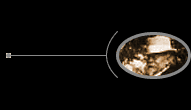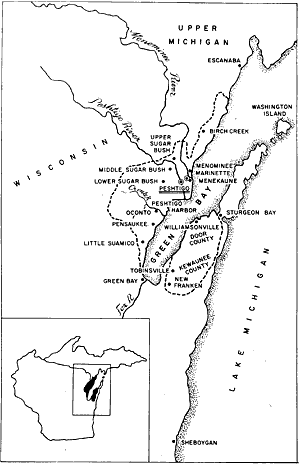


 |
  |
|
|
IT MAY BE as well to record here some of the extraordinary phenomena and peculiar characteristics of the strange fire that wrought so much desolation, though I was not personally a witness to them all. I was too near the inner portion of the circle to be able to see much of what was passing on the outside. It is not he who is in the middle of the combat that has the best view of the battle and its details, but rather the man who contemplates it from some elevated point overlooking the plain. Whole forests of huge maples, deeply and strongly rooted in the soil, were torn up, twisted and broken, as if they had been willow wands. A tree standing upright here or there was an exception to an almost general rule. There lay those children of the forest, heaped up one over the other in all imaginable positions, their branches reduced to cinders, and their trunks calcined and blackened. Many asseverated that they had seen large wooden houses torn from their foundations and caught up like straws by two opposing currents of air which raised them till they came in contact with the stream of fire. They then burst into flames, and, exposed thus to the fury of two fierce elements, wind and fire, were torn to pieces and reduced to ashes almost simultaneously. Still, the swiftness with which this hurricane, seemingly composed of wind and fire together, advanced, was in no degree proportioned to its terrible force. By computing the length of time that elapsed between the rising of the tempest in the southwest, and its subsiding in the northeast, it will be easily seen that the rate of motion did not exceed two leagues an hour. The hurricane moved in a circle, advancing slowly, as if to give time to prepare for its coming. Many circumstances tended to prove that the intensity of the heat produced by the fire was in some places extreme, nay unheard of. I have already mentioned that the flames pursued the roots of the trees into the very depths of the earth, consuming them to the last inch. I plunged my cane down into these cavities, and convinced myself that nothing had stayed the course of combustion save the utter want of anything to feed on. Hogsheads of nails were found entirely melted though lying outside the direct path of the flames. Immense numbers of fish of all sizes died, and the morning after the storm the river was covered with them. It would be impossible to decide what was the cause of their death. It may have been owing to the intensity of the heat, the want of air necessary to respiration--the air being violently sucked in by the current tending upwards to that fierce focus of flame--or they may have been killed by some poisonous gas. It is more than probable that for a moment the air was impregnated with an inflammable gas most destructive to human life. I have already mentioned the tiny globules of fire flying about my house at the moment I quitted it. Whilst on my way to the river, I met now and then gusts of an air utterly unfit for respiration, and was obliged on these occasions to throw myself on the ground to regain my breath, unless already prostrated involuntarily by the violence of the wind. Whilst standing in the river I had noticed, as I have already related, on casting my eye upwards, a sea of flame, as it were, the immense waves of which were in a state of violent commotion, rolling tumultuously one over the other, and all at a prodigious height in the sky, and, consequently, far from any combustible material. How can this phenomenon be explained without admitting the supposition that immense quantities of gas were accumulated in the air?9 Strange to say there were many corpses found, bearing about them no traces of scars or burns, and yet in the pockets of their habiliments, equally uninjured, watches, cents, and other articles in metal were discovered completely melted. How was it also that many escaped with their lives here and there on the cleared land as well as in the woods? The problem is a difficult one to solve. The tempest did not rage in all parts with equal fury, but escape from its power was a mere affair of chance. None could boast of having displayed more presence of mind than others. Generally speaking, those who happened to be in low lying lands, especially close to excavations or even freshly ploughed earth with which they could cover themselves, as the Indians do, succeeded in saving their lives. Most frequently the torrent of fire passed at a certain height from the earth, touching only the most elevated portions. Thus no one could meet it standing erect without paying the penalty of almost instantaneous death. When the hurricane burst upon us, many, surprised and terrified, ran out to see what was the matter. A number of these persons assert that they then witnessed a phenomenon which may be classed with the marvelous. They saw a large black object, resembling a balloon, which object revolved in the air with great rapidity, advancing above the summits of the trees towards a house which it seemed to single out for destruction. Barely had it touched the latter when the balloon burst with a loud report, like that of a bombshell, and, at the same moment, rivulets of fire streamed out in all directions. With the rapidity of thought, the house thus chosen was enveloped in flames within and without, so that the persons inside had no time for escape. |
|
It is somewhat difficult to calculate the extent of territory overrun by the fiery scourge, on account of the irregularity of the course followed by the latter. Still, without exaggeration, the surface thus ravaged, extending from the southwest to the northeast of Peshtigo, may be set down as not far from fifteen to twenty leagues in length by five or six in width. The number of deaths in Peshtigo, including the farmers dwelling in the environs, was not less than one thousand--that is to say, about half of the population. More than eight hundred known individuals had disappeared; but there were crowds of strangers, many of whom had arrived that very morning, whose names had not been registered, and whose number will ever remain unknown. Among those who escaped from the awful scourge, many have since died, owing to the hardships then endured, whilst others are dropping off day by day. A physician belonging to Green Bay has predicted that before ten years all the unfortunate survivors of that terrible catastrophe will have paid the debt of nature, victims of the irreparable injury inflicted on their constitutions by smoke, air, water, and fire.10 If the prediction continues to be as faithfully realized in the future as it has been in the past, my turn will also come. May the construction of the Church of Our Lady of Lourdes, at Marinette, be then completed, so that some grateful hearts may pray there for the repose of my soul. |
 |
9 In his report to Governor C. C. Washburn, Captain A. J. Langworthy, chairman of the Green Bay Relief Committee stoutly upheld the theory that inflammable gas, particularly marsh gas from peat swamps which in the preceding weeks had often burned to a depth of three feet, played a major role in increasing the fire's intensity. He enclosed in his report a statement from Increase A. Lapham supporting the view that "carburetted hydrogen" produced great masses of combustible gas resembling balls of fire which would explode on contact with oxygen. Langworthy also included a letter from C. F. Chandler of the Columbia College School of Mines in New York flatly denying that combustible gases could be produced in the atmosphere. As a final clincher, Langworthy included depositions from Luther B. Noyes, Marinette judge and editor, and from a noted chemist on the faculty of the U.S. Naval Academy, both upholding the gas theory. In 1927 Joseph Schafer attempted a scientific explanation for the great fires of 1871, but it remained for Robert Wells, using research reports furnished by the U.S. Forest Service to supply the most intelligible explanation for the origin and nature of the fire. Conceding that marsh gas may have played a minor role, Wells concludes that the convection column--a whirling chimney of superheated air generated by the fire--suddenly broke through the blanket of heavier, smoke-laden air into the colder air above, thus creating a huge updraft which led to the fire tornado, the whirlwinds, and the curious phenomena reported by survivors. See appendix to the Assembly Journal, 1873; Joseph Schafer, "Great Fires of Seventy-One," in the Wisconsin Magazine of History, 11:96-106 (September, 1927); and Wells, Fire at Peshtigo, 199-214.
10 Although many survivors subsequently died of their dreadful burns and others were disabled for life, the unidentified physician's prediction fortunately did not hold true. When ceremonies were held on the eightieth anniversary of the fire in October, 1951, nineteen survivors were present to witness the unveiling of the first official state marker, erected in the refurbished Fire Cemetery. The oldest survivor was 96. As late as 1958, Fay S. Dooley, curator of Old Wade House and a former Peshtigo resident, was able to identify six survivors still living then. Milwaukee Journal, October 8, 1951; Peshtigo Times, October 4, 1951; William F. Steuber, Jr., "The Problem at Peshtigo," in the Wisconsin Magazine of History. 43:13-15 (Autumn, 1958)